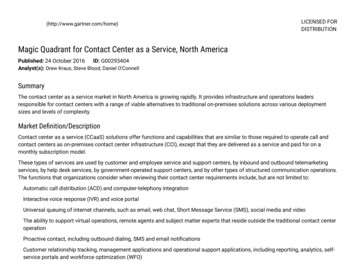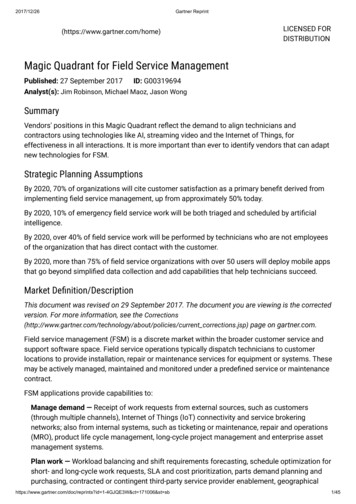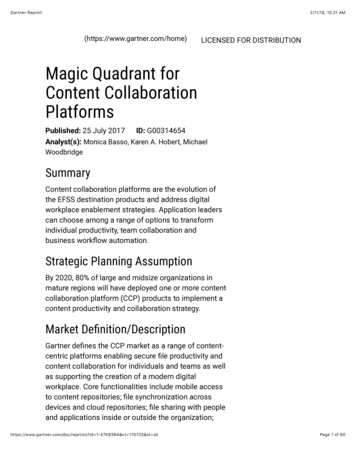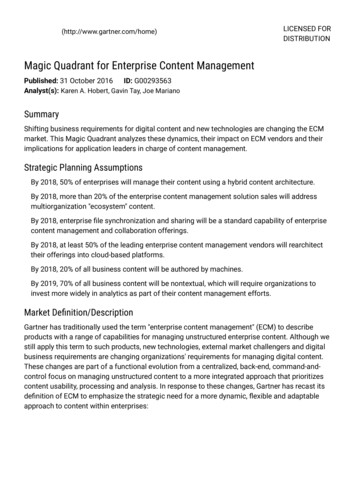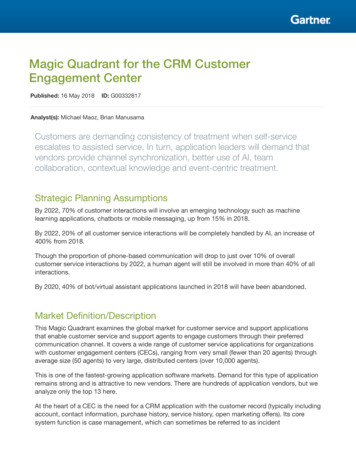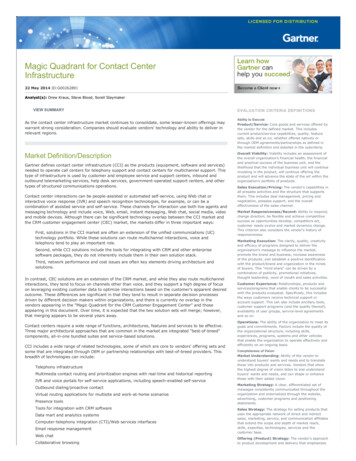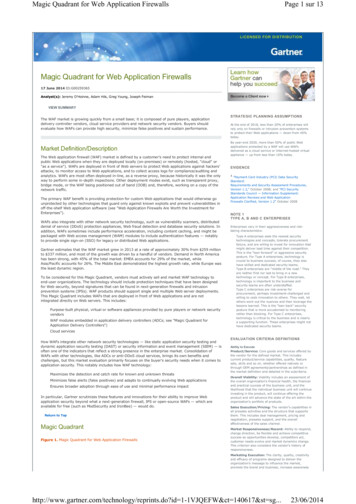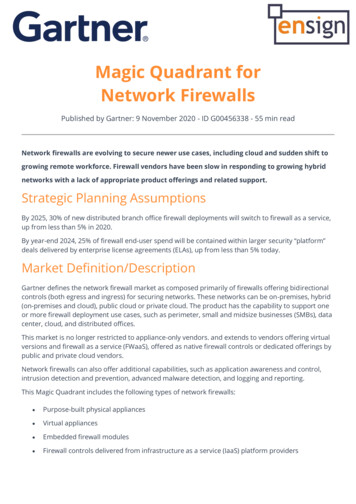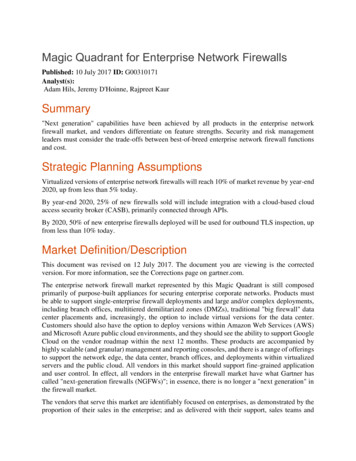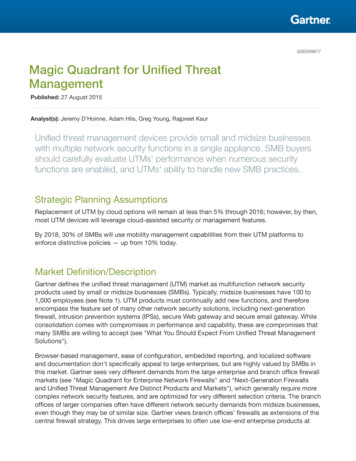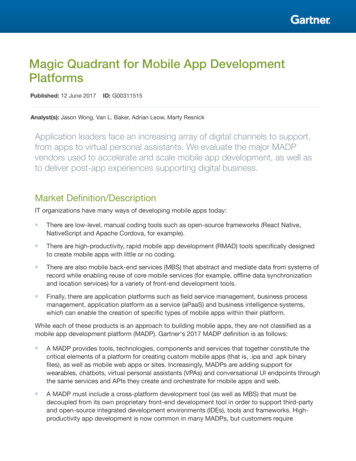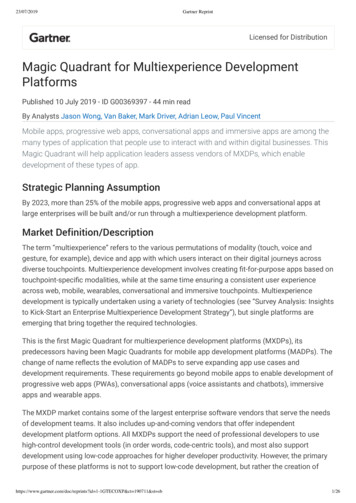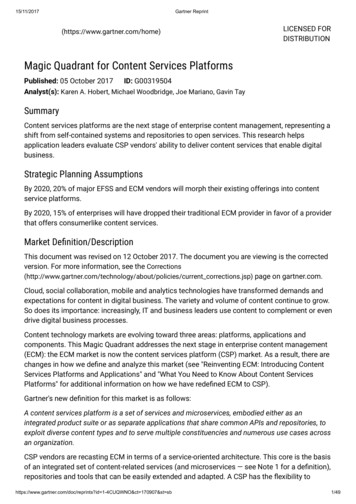
Transcription
15/11/2017Gartner Reprint(https://www.gartner.com/home)LICENSED FORDISTRIBUTIONMagic Quadrant for Content Services PlatformsPublished: 05 October 2017 ID: G00319504Analyst(s): Karen A. Hobert, Michael Woodbridge, Joe Mariano, Gavin TaySummaryContent services platforms are the next stage of enterprise content management, representing ashift from self-contained systems and repositories to open services. This research helpsapplication leaders evaluate CSP vendors' ability to deliver content services that enable digitalbusiness.Strategic Planning AssumptionsBy 2020, 20% of major EFSS and ECM vendors will morph their existing offerings into contentservice platforms.By 2020, 15% of enterprises will have dropped their traditional ECM provider in favor of a providerthat offers consumerlike content services.Market Definition/DescriptionThis document was revised on 12 October 2017. The document you are viewing is the correctedversion. For more information, see the t/policies/current corrections.jsp) page on gartner.com.Cloud, social collaboration, mobile and analytics technologies have transformed demands andexpectations for content in digital business. The variety and volume of content continue to grow.So does its importance: increasingly, IT and business leaders use content to complement or evendrive digital business processes.Content technology markets are evolving toward three areas: platforms, applications andcomponents. This Magic Quadrant addresses the next stage in enterprise content management(ECM): the ECM market is now the content services platform (CSP) market. As a result, there arechanges in how we define and analyze this market (see "Reinventing ECM: Introducing ContentServices Platforms and Applications" and "What You Need to Know About Content ServicesPlatforms" for additional information on how we have redefined ECM to CSP).Gartner's new definition for this market is as follows:A content services platform is a set of services and microservices, embodied either as anintegrated product suite or as separate applications that share common APIs and repositories, toexploit diverse content types and to serve multiple constituencies and numerous use cases acrossan organization.CSP vendors are recasting ECM in terms of a service-oriented architecture. This core is the basisof an integrated set of content-related services (and microservices — see Note 1 for a definition),repositories and tools that can be easily extended and adapted. A CSP has the flexibility tohttps://www.gartner.com/doc/reprints?id 1-4CUQWNO&ct 170907&st sb1/49
15/11/2017Gartner Reprintsupport existing and emerging content use cases. It has its own repository but should also beable to integrate external repositories through connectors, APIs or packaged integrations. Today,many CSPs can be deployed on-premises, in the cloud or in hybrid architectures.A CSP is characterized in part by the breadth of its support for content types and formats overthe entire content life cycle. Key capabilities include:Capturing and ingesting content in digitized formats, including scanning, content migration,user-created content or autogenerated content.Managing and retaining digitized content and associated metadata, including contentassociated with systems of record, file sync and transfer, search and findability, and metadatamanagement.Processing digital business content, including developing workflows, and integrating withenterprise systems and data, line-of-business (LOB) processes, and purpose-focusedapplications.Improving user productivity through more-effective finding and use of digitized content indigital business initiatives.Providing platform services that combine integrated, content-related services andmicroservices, repositories, publicly available APIs for application integration, andadministrative tools.Providing platform services that combine integrated, content-related services andmicroservices, repositories, logical information layers, and centralized administration ofservices and management tools.Integrating and extending the platform, content and interfaces to commonly used productivity,LOB and ERP systems through publicly available APIs for application integration,multirepository support, data integration extensions and out-of-the-box connectors.For a more complete listing of CSP functions and capabilities, see the Appendix.Since the CSP market is an evolving market in 2017, we have updated the representative vendors,inclusion criteria and evaluation criteria. And while it has evolved from the ECM market, there aresignificant differences with respect to the makeup of its vendors. As such, the new lineup ofevaluated vendors includes those we have evaluated in previous Magic Quadrants for ECM andthose that would not have classically fit into the ECM market. The latter group comprises thosethat were strictly platforms that did not offer packaged solutions, focused on a single verticalmarket, were too geographically localized or delivered lighter-weight content servicesfunctionality, among others.Magic QuadrantFigure 1. Magic Quadrant for Content Services Platformshttps://www.gartner.com/doc/reprints?id 1-4CUQWNO&ct 170907&st sb2/49
15/11/2017Gartner ReprintSource: Gartner (October 2017)Vendor Strengths and CautionsAlfrescoAlfresco (https://www.alfresco.com/) is headquartered in Maidenhead, U.K., and San Mateo,California, U.S., with offices in Atlanta, U.S., Australia, France and Germany. The Alfresco DigitalBusiness Platform comprises several services for content, processes, governance, integrationand extension. The platform is built on an open-source core that leverages industry standardsand open-standard APIs. The result is ready-to-use integrations with various productivityapplications; the integrations can be customized and extended. Alfresco's Content Servicesmesh with its Process Services (Activiti-powered BPM) and Governance Services (automatedrecords management). Deployment options are on-premises, in the cloud (SaaS and managed)and hybrid. Alfresco focuses on regulated industries including financial services, government,insurance, manufacturing, education and healthcare. Alfresco is a good fit for organizations thatlike to build their own applications and want the full control to do so.https://www.gartner.com/doc/reprints?id 1-4CUQWNO&ct 170907&st sb3/49
15/11/2017Gartner ReprintSTRENGTHSAlfresco's open-source approach and extensive APIs and interfaces enable customers to easilycustomize its content services to their organization's specific requirements.Alfresco has taken steps to enhance its technology partnerships to advance differentiation andinnovation, such as being the first content services provider on Amazon to be able to launch anAlfresco instance with an Amazon Web Services Quick Start button.In addition to Alfresco support offerings, there is a strong and active Alfresco user communitythat provides additional peer-to-peer support. Reference customers interviewed for this MagicQuadrant rated the community highly as a source of shared advice, support and information.CAUTIONSAlfresco lags behind other vendors in this market in the development of on-demand, pluggableservices and connectors to external line-of-business, ERP and other content servicesapplications. It relies on partners and third-party offerings to deliver connectors andextensions.Alfresco's platform currently does not fully or flexibly support the growing number of contentrepositories that are now typical for digital business.Reference customers interviewed for this Magic Quadrant reported dissatisfaction withAlfresco's "ability to understand their organization's needs" and "derived value provided by theproduct."BoxBox (https://www.box.com/) is a public company founded in 2005, based in Redwood City,California, U.S., with offices in Europe and Japan. Originally, it focused on content collaborationservices (previously labeled enterprise file synchronization and sharing [EFSS]). Today, it offerstwo products: Box, a package of CSP features and user interfaces, and Box Platform, a cloudnative API for extending content services to enterprise systems and a platform for buildingcustom applications. Both are available in the public cloud only, implemented in the vendor's owndata centers in the U.S., or through Amazon Web Services, Microsoft Azure (recently announced)or IBM's local data centers in other regions. Box markets the offerings as a simplified,consumerized, cost-effective and agile set of CSP services that underpin digital transformation.It has about 76,000 customer organizations, 15,000 using the Box API, with a concentration inhealthcare, professional services and financial services. It has about 10 million paying Box users.Many customers initially start with Box's foundational content collaboration services and expandtheir deployments into the Box Platform content services. Box Platform is a good fit fororganizations modernizing content services approaches and leveraging cloud-based services tobuild customized content-oriented applications and interfaces.STRENGTHSUsability is a primary differentiator for Box, and its success here is reflected in the feedbackfrom the reference customer surveys, where Box rated highly in terms of ease of use.The Box platform is particularly well-suited for content processes that span organizationalboundaries, such as enabling collaboration between partner ?id 1-4CUQWNO&ct 170907&st sb4/49
15/11/2017Gartner ReprintReference clients rated Box professional and support services highly, commenting that the Boxsupport team was knowledgeable and proactive in solving any problems during theimplementation and customization of the platform.CAUTIONSBox's content management features — such as metadata, retention management, workflow,team workspace management — are stripped down compared with those of rival CSPs. Theymay not be robust enough to replace some legacy ECM capabilities.Box Platform has no capability to give customers insight, governance or functionality forremote repositories other than its cloud-only content repository.Reference clients expressed frustration with delays in meeting roadmap commitments forcritically anticipated features — specifically Box Drive and Box Relay (still in beta), which havehad very long development times compared to other content services.ComarchComarch (http://www.comarch.com/) is an IT services and software company based in Krakow,Poland, with offices worldwide. Its biggest presence is in Europe, specifically the DACH region.The Comarch CSP, introduced in 2008, has a broad range of content-related capabilities andseveral dedicated vertical solutions. Comarch CSP can be procured as an on-premises solutionor in the cloud, as a SaaS solution run from Comarch's network of data centers operated acrossthe world. Comarch is designed as an enterprise content services solution to address full contentmanagement needs, including document capture, OCR, workflow, records, life cycle andarchiving. Comarch offers packaged solutions for specific verticals, including healthcare, retail,manufacturing, banking and insurance. It has over 500 customers and about 270,000 users.Customers range from small to large organizations, and the largest bloc is in manufacturing.Comarch's solution is a good fit for EMEA-centered organizations that want traditional contentmanagement capabilities to address the full range of content, processing, records and life cycleof their enterprise content and business processing.STRENGTHSComarch has a good set of "traditional ECM" features, such as document management,capture and workflow. These features are available in both the on-premises and cloudofferings.Though Comarch markets its CSP as a horizontal solution, it has several strong industryspecific content services applications in healthcare, CRM, ERP and finance.Reference customers surveyed for this report rated Comarch highly for its prompt andknowledgeable implementation support. All of them said that they would recommend Comarchto other, similar organizations.CAUTIONSComarch has few large, global enterprise customers. Prospects that need scalability andgeographic reach should validate with the vendor and reference accounts that Comarch cansupport their requirements.The Comarch platform is maturing and currently offers basic functionality, in comparison toother CSPs, for social and collaboration, reporting and analytics, and integration id 1-4CUQWNO&ct 170907&st sb5/49
15/11/2017Gartner ReprintThe overall user experience of the Comarch platform has not kept abreast with those of otherCSP vendors in terms of usability requirements, such as adaptive user interfaces acrossdevices.DocuWareDocuWare (https://www.docuware.com/) is based in Germering, Germany. Its CSP offerings includeDocuWare for document capture and management, DocuWare Workflow for businessprocessing, and DocuWare Intelligent Indexing for metadata management and content indexing.All are available either on-premises or in a multitenant cloud built on a Microsoft Azureinfrastructure. DocuWare has regionalized sale directors in Europe, North America and LatinAmerica. It is expanding globally in Western Europe, South Africa and the Middle East as part of anew market expansion program. The vendor offers horizontal processing solutions such asinvoicing, purchasing, employee onboarding and other common business processes. Itspecializes in document processing for the automotive, government (financial processes),manufacturing, educational and retail verticals. DocuWare is a good fit for small and midsizeenterprises looking for traditional content management capabilities, with flexible purchasingoptions and delivery models.STRENGTHSDocuWare's cloud and on-premises offerings have feature parity for seamless hybriddeployment. They let customers of all sizes acquire traditional content services that focus oncore features: imaging, document management, workflow, intelligent indexing and contentarchiving.DocuWare is strongest in the EMEA and North American markets, is expanding throughoutWestern Europe and South Africa, and is increasing its current visibility in the Latin Americanand Middle Eastern markets.Reference customers reported high levels of overall satisfaction with their DocuWareimplementation, citing how the product offers good value, how responsive the vendor is to theirneeds, and how the product has been enhanced to meet their requests.CAUTIONSDocuWare has been slow to incorporate emergent content services features, such as contentanalytics and multirepository support deployment. It is lagging behind competitors in thismarket.DocuWare focuses its marketing and sales efforts on delivering horizontal use cases foraccounting, finance, human resources and customized applications. It does not market to, oroffer direct sales and solutions focused on, specific industries, which may not be a match forsome industry-specific content services requirements.Some customers say that customizing or integrating the DocuWare environments with othersystems is difficult, and that professional services support is required for specializedintegrations.EverteamEverteam (http://www.everteam.com/) is headquartered in Lyon, France, with a U.S. regionalheadquarters in Boston, Massachusetts and regional offices in Europe, the Middle East and Asia.Its CSP suite, Everteam, includes everteam.document, everteam.capture, ?id 1-4CUQWNO&ct 170907&st sb6/49
15/11/2017Gartner Reprinteverteam.records, everteam.archive, everteam.process and everteam.analytics. The platform isavailable as on-premises software or a SaaS-based cloud service. It is a mature product, withinformation governance and a wide range of content capabilities, from document managementto workflow and business processing. The company is investing heavily in redeveloping theproduct into a microservice platform for content-centered application development. It's alsoinvesting in natural-language processing and machine learning for content and file analyticsservices, with autoclassifying, tagging and managing files across multiple repositories, includingECM stores. The CSP offers publicly available APIs with connectors to many common contentservices. Everteam's partner network offers regionalized solution development, productimplementation and support. The vendor sells mainly to midsize and large enterprises as well asgovernment agencies in Europe and the Middle East, but has been expanding in North America,Asia/Pacific and Latin America. Key vertical practices are engineering, government, insuranceand utilities. Everteam is a good fit for customers that need expanded and innovative approachesto the processing, analytics and oversight of unstructured content.STRENGTHSEverteam's new microservice architecture includes a modernized application layer for buildingcontent-centric applications and interfaces.Everteam's emphasis on governance — through content and file analytics for tagging andclassification of content across multiple repositories and systems — aligns with customers'content services strategies for cross-repository openness and centralized oversight.Reference customers reported high levels of satisfaction with their Everteam investment, fromprocurement to implementation to support. They gave the vendor high marks for its supportand implementation expertise.CAUTIONSOutside of the EMEA market, Everteam's market presence is still maturing and relies entirely onimplementation partners. Customers should work with the vendor to identify partners that arefully experienced in Everteam solution delivery.Everteam struggles to articulate the services-oriented transformation of its platform and valueproposition, with inconsistent messaging and strategies, especially in maturing regions suchas the U.S. The market assumes that it is still a regionally focused ECM provider.In Gartner surveys, customers have said that Everteam is inconsistent in how completely itimplements functions, requiring additional effort by customers to integrate or enhance theplatform.FabasoftFabasoft (https://www.fabasoft.com/) is a software vendor and cloud services providerheadquartered in Austria. It offers two on-premises CSP products, Fabasoft Folio and FabasofteGov-Suite, and a Europe-based cloud offering, the Fabasoft Cloud. Fabasoft's cloud platformsare deployed via appliances, making for simplified and rapid implementation of the vendor's CSPservices in any cloud environment — public or private. Fabasoft offers app.ducx and app.testdevelopment modules for modeling, developing and testing customized customer solutions. TheFabasoft platform is an integrated solution that covers all parts of the document life cycle anddigital records management. The vendor targets highly regulated businesses that are subject tothe General Data Protection Regulation (GDPR) and other data privacy regulations. Its adaptivehttps://www.gartner.com/doc/reprints?id 1-4CUQWNO&ct 170907&st sb7/49
15/11/2017Gartner Reprintclient interface includes integrations into Microsoft Office, Microsoft Office 365 and many otherproductivity tools. Its primary focus market is the European Union, specifically regulatedindustries including manufacturing, healthcare, finance and the public sector. Fabasoft's CSPcapabilities are tightly integrated with Mindbreeze InSpire, an enterprise insight and searchappliance owned by the Fabasoft Group. It is a good match for regulated businesses with a needfor content classification, insight, records and content life cycle management.STRENGTHSThe Fabasoft platform supports broad integration with content and data systems for processoriented use cases.Tight integration with Mindbreeze InSpire is a key differentiator for Fabasoft in this market,providing extended autoclassification, business process management and
Magic Quadrant for Content Ser vices Platforms Published: 05 October 2017 ID: G00319504 Analyst(s): Karen A. Hober t, Michael Woodbridge, Joe Mariano, Gavin Tay Summar y Content ser vices platforms ar e the next stage of enterprise content management, r epresenting a shift from self-contained systems and r epositories to open ser vices.
